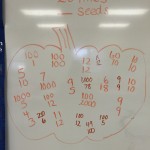As I was looking over my photos and Seesaw posts for this month, I was a bit surprised at how much we have explored in just a couple of weeks. We focused on a snow theme at first and got to build a snowman with fake snow we made in class. Just stir together three cups of baking soda and one cup of white hair conditioner and you get a mixture that has the consistency of packable snow without the freezing hands. We also made artistic snowmen in a variety of ways. They are currently decorating our room.
We read and retold The Mitten by Jan Brett many times. The children love to act out the part when the bear sneezes and all the animals go flying in the air! Retelling a familiar story builds stronger comprehension skills and gives much needed verbal practice.
I introduced an ice cube challenge that got their brains thinking with determination. How can you pick up an ice cube using just a string? No hands on the ice cube either! We had a few successes once I provided some salt. I love how engaged and creative the students get when presented with an interesting problem to solve.
We also grew beautiful crystals using a super saturated solution of Borax in hot water. Here’s how we did it: start with three cups of very hot water and add 1/2 cup Borax laundry booster. Stir in more Borax until no more will dissolve. Twist and shape a pipe-cleaner and hang it from a stick so it doesn’t touch the sides or bottom of a clear jar. Pour in the solution. Don’t disturb the jar! In about an hour you will see crystals begin to form. The longer you leave it, the more crystals form on the pipe-cleaner.
This month has been made special with guest teachers helping us learn. Mrs. Stark has been providing music lessons. She has introduced us to different styles of musical compositions and use of voice. Beethoven’s Moonlight Serenade had an impressive and immediate calming effect on the whole class!
Mrs. Tweedt has been teaching us about arctic animals. We get to draw the animals as we make our own book. We couldn’t secure a connection for our videoconference with the park rangers in Alaska but we have explored mini icebergs in the classroom. I’ll keep trying to find a solution the the connectivity issue so we can reschedule that virtual fieldtrip.
I hope you are enjoying the photos and videos on our Seesaw blog. Be sure to leave a few comments for your child. It makes quite an impression when we read them in class.










